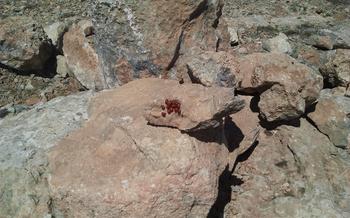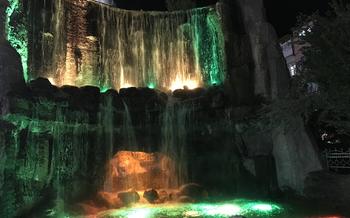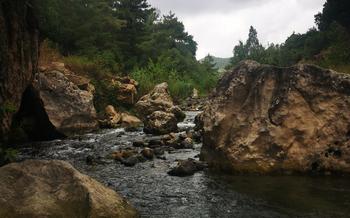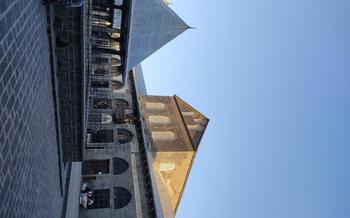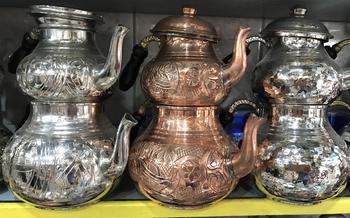
Arapkir Stone Bridge
- A Historical Monument in Malatya: Arapkir Stone Bridge
- Location and Accessibility
- History and Construction
- Architectural Details
- Engineering Marvel
- Witness to History
- A Place of Tranquility
- Local Legends and Folklore
- A Popular Destination for Photography
- Exploring the Surrounding Area
- Preservation Efforts and Restoration
- Visiting the Arapkir Stone Bridge
- Respecting Local Customs and Traditions
- Insider Tip: Unveiling the Hidden Gem
A Historical Monument in Malatya: Arapkir Stone Bridge
The Arapkir Stone Bridge stands as a testament to the rich history and architectural prowess of Malatya. Built in the 12th century during the reign of the Artuqid dynasty, this ancient bridge has witnessed countless historical events and played a pivotal role in trade and cultural exchange. Its impressive architectural features, including its graceful arches, sturdy pillars, and intricate decorative elements, showcase the ingenuity and craftsmanship of its builders. The bridge holds deep cultural significance for the people of Malatya, symbolizing resilience, continuity, and the enduring legacy of past civilizations.
Location and Accessibility
The Arapkir Stone Bridge is situated in the picturesque town of Arapkir, which is located approximately 70 kilometers northeast of Malatya city. To reach the bridge, visitors can take a scenic bus ride or rent a car and enjoy the beautiful countryside scenery along the way. The journey takes about an hour and a half, offering an opportunity to immerse in the region's natural beauty and quaint villages. Upon arrival in Arapkir, the bridge is conveniently located near the town center, making it easily accessible on foot or by local transportation. Its close proximity to other attractions, such as the historic Arapkir Castle and the vibrant town square, allows for a comprehensive exploration of the town's rich history and cultural heritage.
History and Construction
The Arapkir Stone Bridge stands as a testament to the ingenuity and engineering prowess of its builders. Its construction dates back to the 12th century, during the reign of the Artuqid dynasty, a period marked by significant architectural achievements throughout Anatolia. The exact year of its completion remains shrouded in mystery, adding to the bridge's allure and historical significance.
The bridge's construction involved meticulous planning and skilled craftsmanship. Local materials, primarily stone and mortar, were carefully selected and shaped to create a structure that would withstand the test of time. The builders employed innovative techniques, such as the use of pointed arches and sturdy piers, to ensure the bridge's stability and resilience.
Historical records suggest that the bridge served as a vital trade route connecting the eastern and western regions of Anatolia. It facilitated the movement of goods, ideas, and people, contributing to the region's economic and cultural development. The bridge's strategic location along the banks of the Euphrates River further enhanced its importance as a hub for trade and cultural exchange.
Architectural Details
The Arapkir Stone Bridge stands as a testament to the remarkable craftsmanship and engineering prowess of its builders. Its architectural features are a harmonious blend of functionality and aesthetics, showcasing innovative design elements that set it apart from other ancient bridges.
Unique Structural Elements
One of the most striking aspects of the bridge is its unique structural system. Instead of relying on conventional piers, the bridge features a series of massive stone arches that span the river, creating a sturdy and resilient structure. These arches are not merely functional but also visually appealing, with their graceful curves adding a touch of elegance to the bridge's overall appearance.
Distinctive Arches and Pillars
The bridge's arches are not uniform in size or shape, but rather vary in height and width, creating a dynamic and visually interesting composition. The pillars supporting the arches are equally distinctive, featuring intricate carvings and decorative elements that reflect the artistic sensibilities of the period. These pillars serve not only as structural supports but also as decorative elements, adding to the bridge's aesthetic appeal.
Decorative Features and Inscriptions
In addition to its structural elements, the Arapkir Stone Bridge is adorned with a variety of decorative features and inscriptions. These include intricate carvings depicting geometric patterns, floral motifs, and even human figures. There are also several inscriptions in Arabic and Persian, providing valuable insights into the bridge's history and cultural significance. These decorative elements transform the bridge into a work of art, showcasing the artistic prowess of its creators.
Engineering Marvel
The Arapkir Stone Bridge stands as a testament to the remarkable engineering achievements of the past. Constructed without the aid of modern machinery or tools, the bridge showcases innovative techniques that have ensured its resilience and durability over time.
The bridge's design features a series of arches that efficiently distribute the weight of the structure, allowing it to withstand the test of time and the forces of nature. The arches are supported by sturdy pillars that rise from the riverbed, providing a solid foundation that has resisted erosion and flooding.
The Arapkir Stone Bridge's construction demonstrates a deep understanding of structural mechanics and engineering principles. Its innovative design has enabled it to remain intact for centuries, serving as a remarkable example of the ingenuity and skill of ancient builders.
Comparing the Arapkir Stone Bridge with other ancient bridges reveals its uniqueness and significance. While many ancient bridges employed similar arch designs, the Arapkir bridge stands out for its exceptional longevity and the remarkable preservation of its original structure.
The bridge's resilience is attributed to the careful selection of materials and construction techniques. The use of locally sourced stone, coupled with the precise placement of each block, has contributed to the bridge's ability to endure the passage of time and the elements.
The Arapkir Stone Bridge serves as a reminder of the remarkable engineering feats accomplished by ancient civilizations. Its innovative design and enduring strength showcase the ingenuity and expertise of our ancestors and continue to inspire modern engineers and architects.
Witness to History
The Arapkir Stone Bridge has borne witness to countless historical events throughout its existence. In ancient times, it served as a crucial artery for trade and cultural exchange between the East and the West. Caravans laden with exotic goods traversed the bridge, connecting distant lands and fostering economic and cultural interaction.
During the Byzantine era, the bridge played a strategic role in defending the empire's eastern frontiers. It served as a fortified outpost, with watchtowers and defensive structures safeguarding the passage against invading forces.
In later centuries, the bridge witnessed the rise and fall of various empires and dynasties. It endured invasions, battles, and political upheavals, remaining a steadfast symbol of resilience and continuity amidst the changing tides of history.
The bridge's strategic location made it a focal point for military campaigns and political struggles. Armies marched across its ancient stones, seeking to control the vital trade routes and secure their dominance over the region.
Despite the tumultuous events it has witnessed, the Arapkir Stone Bridge has stood firm, its foundations unshaken by the passage of time. It continues to serve as a reminder of the rich history and enduring legacy of the region.
A Place of Tranquility
The Arapkir Stone Bridge offers a sanctuary of peace and tranquility amidst the bustling city of Malatya. As you approach the bridge, the surrounding noise gradually fades away, replaced by the gentle murmur of the river below and the soothing sound of birds chirping in the trees. The bridge's serene ambiance invites you to slow down, relax, and immerse yourself in the moment. Whether you choose to sit on one of the benches lining the bridge or simply lean against the stone railing, you'll find yourself enveloped in a sense of tranquility that washes away all your worries and stresses. The bridge is also an ideal spot for contemplation and reflection, providing a unique perspective from which to observe the world go by.
As you gaze out over the river, you'll be treated to panoramic views of the surrounding landscape. The lush green trees that line the riverbanks create a vibrant contrast to the pale stone of the bridge, while the distant mountains add a touch of drama to the scenery. The bridge itself becomes a frame through which you can admire the beauty of nature, capturing the changing colors of the sky as the sun rises and sets. Whether you're seeking a moment of respite from the hustle and bustle of city life or simply looking for a place to connect with nature, the Arapkir Stone Bridge is the perfect destination.
Local Legends and Folklore
The Arapkir Stone Bridge is not just a historical monument but also a source of inspiration for local legends and folklore. Myths and tales have been woven around the bridge for centuries, passed down from generation to generation through oral tradition. One popular legend tells the story of a young couple who were forbidden from marrying due to their different social backgrounds. They decided to elope and meet under the bridge at midnight. As they ran away together, the bridge miraculously parted, allowing them to cross safely.
Another legend speaks of a hidden treasure buried beneath the bridge. According to the tale, a wealthy merchant once hid his fortune under the bridge to protect it from invading armies. He was killed in battle, and the secret of the treasure was lost. Many have searched for the hidden wealth, but none have succeeded.
These legends add to the mystique and charm of the Arapkir Stone Bridge, making it not just a historical relic but a symbol of local culture and imagination. They remind us of the rich tapestry of stories and traditions that surround ancient landmarks, connecting us to the past and inspiring our imaginations.
A Popular Destination for Photography
The Arapkir Stone Bridge has become a popular destination for photographers and enthusiasts of visual arts. The bridge's captivating design, historical significance, and picturesque surroundings make it an ideal subject for photography. Capture the grandeur of the bridge's arches against the backdrop of the river and the lush greenery.
Tips for Capturing the Best Shots:
-
Early morning or late afternoon light: Take advantage of the golden hours of sunrise and sunset for the most dramatic and vibrant lighting conditions.
-
Experiment with angles: Explore different perspectives and angles to create dynamic compositions. Capture the bridge from below to emphasize its height or from a distance to showcase its full majesty.
-
Include the surroundings: Incorporate elements of the natural landscape, such as the river, trees, and mountains, into your shots to create a sense of depth and context.
-
Use a tripod: A tripod will help you stabilize your camera and achieve sharp, clear images, especially in low-light conditions.
-
Play with reflections: The river's surface provides an opportunity for creative reflections of the bridge. Experiment with different shutter speeds to capture the movement of the water and create interesting effects.
Exploring the Surrounding Area
The Arapkir Stone Bridge is not just a standalone attraction; it is also a gateway to a wealth of historical and cultural treasures in the surrounding area. History buffs can delve into the ancient ruins of the nearby Arslantepe Mound, one of the oldest continuously inhabited settlements in the world. This archaeological site boasts impressive fortifications, temples, and artifacts that shed light on the region's rich past.
For those seeking a taste of local culture, the charming village of Arapkir offers a glimpse into traditional Turkish life. Wander through its narrow streets, visit the vibrant local market, and savor the flavors of authentic Turkish cuisine in one of the many traditional restaurants. The village is also home to several historical mosques, churches, and mansions that showcase the region's diverse architectural heritage.
Nature enthusiasts can embark on a scenic hike along the banks of the Tohma River, which offers breathtaking views of the bridge and the surrounding countryside. The area is also home to several natural springs, waterfalls, and lush forests, providing ample opportunities for exploration and relaxation.
Whether you're interested in history, culture, or the great outdoors, the area surrounding the Arapkir Stone Bridge offers a wealth of experiences that will enrich your visit to Malatya.
Preservation Efforts and Restoration
The Arapkir Stone Bridge has undergone several restoration and preservation efforts to ensure its longevity and historical integrity. In the early 20th century, the bridge faced structural challenges due to weathering and erosion. Recognizing its significance, local authorities initiated restoration work to reinforce the bridge's foundations and repair damaged sections.
A comprehensive restoration project was undertaken in the 1970s, involving meticulous cleaning and repairs to restore the bridge to its former glory. Skilled artisans and engineers worked diligently to preserve the original architectural features and materials, ensuring the bridge's authenticity.
Preserving historical landmarks like the Arapkir Stone Bridge is crucial for several reasons. These structures hold immense cultural, historical, and architectural value, connecting us to our past and providing insights into the craftsmanship and engineering prowess of ancient civilizations. Preserving them ensures that future generations can appreciate and learn from these remarkable achievements.
Moreover, historical landmarks often serve as symbols of local pride and identity. They contribute to the unique character of a place, attracting visitors and fostering cultural appreciation. By preserving these landmarks, we safeguard our heritage and promote cultural tourism, which can have positive economic and social impacts on local communities.
The preservation of the Arapkir Stone Bridge stands as a testament to the importance of protecting our cultural heritage. Through ongoing efforts and collaboration between experts, communities, and authorities, we can ensure that this magnificent bridge continues to stand as a symbol of resilience and a source of inspiration for generations to come.
Visiting the Arapkir Stone Bridge
The best time to visit the Arapkir Stone Bridge is during the spring or autumn months, when the weather is pleasant and conducive to outdoor exploration. The bridge is accessible throughout the day, offering visitors the flexibility to choose their preferred time to experience its grandeur.
For a comprehensive visit, it is recommended to allocate at least an hour to explore the bridge and its surroundings. This duration allows ample time to admire the architectural details, take photographs, and soak in the tranquil ambiance. For those seeking a deeper understanding of the bridge's history and significance, guided tours are available, providing valuable insights and anecdotes.
The Arapkir Stone Bridge is wheelchair accessible, ensuring that visitors with disabilities can also enjoy this historical landmark. Ramps and designated pathways have been thoughtfully incorporated to facilitate easy access for all.
Respecting Local Customs and Traditions
When visiting the Arapkir Stone Bridge, it is essential to be mindful of local customs and traditions to ensure a respectful and enriching experience. As a visitor, respecting the local culture will not only enhance your own experience but also contribute to preserving the bridge's significance and the hospitality of the community.
Dress modestly and avoid revealing clothing, especially when visiting religious or conservative areas. When interacting with locals, be polite and greet them with a friendly "Merhaba" (hello). It is customary to shake hands with men and women, but always wait for them to initiate the gesture.
Be mindful of your behavior and avoid public displays of affection, as these may be considered inappropriate in the local culture. Photography is generally permitted, but always ask for permission before taking pictures of people, especially women.
When visiting religious sites, such as mosques or churches, remember to remove your shoes before entering and dress appropriately. It is also essential to be respectful of local religious practices and customs.
By observing these cultural norms and showing respect for the local community, you will contribute to a positive and harmonious experience for yourself and those around you, making your visit to the Arapkir Stone Bridge even more memorable.
Insider Tip: Unveiling the Hidden Gem
Beyond the main viewpoint, there's a hidden gem waiting to be discovered for those willing to explore. Follow a small, winding path that leads beneath the bridge, where you'll find a secluded spot offering a unique perspective. This hidden vantage point allows you to immerse yourself in the bridge's grandeur, capturing its intricate details from a fresh angle.
Look closely, and you might uncover hidden inscriptions etched into the stones, revealing secrets from the bridge's past. These inscriptions, often overlooked by casual visitors, offer a glimpse into the lives of those who built and crossed the bridge centuries ago. Discovering these hidden treasures adds a layer of depth and intrigue to your visit, making it a truly memorable experience.
